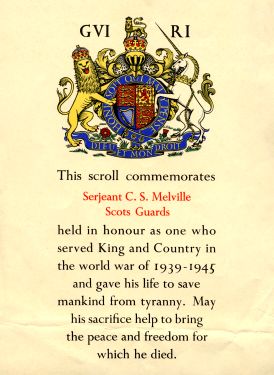
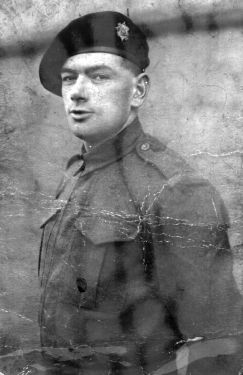
| CATHEL SUTHERLAND MELVILLE (1914 - 1945) |
[ Home ] |
Cathel
Sutherland Melville, the son of George Melville and Annie
Fraser and born in
Cathel’s
Army records on enlistment show him to be in A1 medical
condition, 5 feet 10 inches tall, 168 lbs weight and having
black hair and brown eyes. He reached the rank of Lance
Sergeant in the Scots Guards but was tragically killed in
World War Two when on active service in
The
Golspie War Memorial records Cathel’s service to his country
and his death and he is remembered on the Commonwealth War
Graves Commission Roll of Honour. He was married to
At the time of his death Cathel was serving
with the 2nd Scots Guards Infantry Division and was involved
in the final push of the allied forces against the German
defences in the area to the east of the Rhine and the most
immediate target at this time there being
David Erskine's book 'The Scots Guards 1919 -
1955 has relevant information for 5th and 6th April 1945 as on
page 434 he states:
April 5
The 5th
was chiefly notable for an ineffective low-flying attack by
fighters on the Group’s rest positions along the
Nordhord-Lingen road at a moment when the Brens were being
and by the 3rd Division clearing enough of Lingen area to
make a further advance possible.
April 6
In the
morning of the 6th the Group set off once more, crossed the
Coldstream bridge, and moved out along the axis road by the
The
loss of Major Kemble was a particularly heavy blow; he had
been wounded and awarded the Military Cross when seconded to
the King’s African Rifles in the East African campaign, and
had again been wounded, losing the sight of one eye, while
serving with the Battalion in North Africa. A great
personality and leader of men, he was leading the Company in
the attack when he was killed; he was succeeded in command
by Captain JS. Burn-Clerk-Rattray.
The new
route was little better, and further opposition, during
which the Group lost a tank and a carrier on mines,
Lieutenant Mannock was wounded, and four enemy 88-mm. guns
were knocked out by the Welsh tanks, led to the Group still
being short of Lengerich at nightfall. The day had been
typical of many there were to follow: a fighting withdrawal
forcing frequent deployments and infantry assaults, in
circumstances which allowed just enough mobility to warrant
the use of tanks, over eighty of which were to be lost
before the close of the campaign.
It is worth noting that this Scots Guards
regimental history by Erskine states that Cathel was serving
with 2nd
(Infantry) Battalion Scots Guards when he died and
this full description does not appear on correspondence sent
to his widow nor does it appear on the gravestone in Sage
where he is just given as Scots Guards. However, the
temporary grave marker does given his unit as 2nd Scots
Guards.
Scots Guards units were working along with
Welsh Guards in this operation as the allied force tried to
make headway to Bremen initially by the Lingen to Freren
axis
and later when this route failed by a more northern route to
Lengerich. A report of the
fighting and progress from the Welsh Guards perspective give
a very good picture of the terrible conditions endured in
this advance from Lingen,
From Welsh Guards at War by Major L F Ellis,
page 277, an account of the day from the perspective of 2nd Bn
Welsh Guards:
6th of
April. -
(2
a.m.) Am just going to bed after a long series of ‘O’
Groups. Our first task is to make a break-out from the
Lingen bridgehead and then go to as fast as we can to
(8.15
a.m.) We are off.
(9.15
a.m.) Leading tank knocked out on a mine. R.E. are clearing
the road.
(10
a.m.) Advance resumed. Leading tank fired on from the right
- and missed - but the second tank hit and knocked out. Have
sent the troop to the right in a flanking movement.
(10.30
a.m.) This was successful.
(10.45
a.m.) Leading tank of the troop who have taken over the lead
has been knocked out by another bazooka and simultaneously
hit a mine. There is another road-block in front with
bazooka men and anti-tank gun manning it.
(10.50
a.m.) A severe stonking ... my scout car was hit and put out
of action.
(11.15
a.m.) An infantry attack on wooded area to our front is
going in - ‘F’ Company Scots Guards, supported by my leading
troops and some artillery. This is
(1
p.m.) The infantry are having bad casualties ... David
Kemble, commanding ‘F’ Company has been badly wounded
...
(2
p.m.) Have just heard that David Kemble has died of his
wounds/
(3.15
p.m.) No. 2 and No. 3 Squadron Groups are to put in a joint
attack.
(5
p.m.) They have made their attack successfully and are now
pushing on, with No. 2 Squadron leading.
(5.10
p.m.) Leading tank of No. 2 Squadron reported hit by a
self-propelled gun.
(6.15
p.m.) No. 2 Squadron report two 88’s in their area and our
air O.P. reports that at least three more are a little
farther on.
(6.30
p.m.) Leading troop of No. 2 Squadron have knocked out no
less than three of the anti-tank guns.
(7
p.m.) They have knocked out a fourth.
(10
p.m.) In harbour just off the road. I have been lucky. I was
sent for to an ‘O’ Group ... when I got back I found my own
tank had been hit by one of the moaning minnies and my
gunner, sitting on my seat, exactly where I would have been,
had been very badly wounded.”
Two
officers nearby were also wounded and the crew of a Scots
Guards carrier were killed.
There is no indication that the latter mentioned Scots
Guards casualties included Cathel Sutherland Melville and it
is more like that his death in action was at around the time
and place where David Kemble, Commanding F Group, received
injuries which lead to his death. It would
have been at about that time that the F Infantry Company
Scots Guards were in the vicinity of Baccum and came up
against the hostile troops and blocked roads.


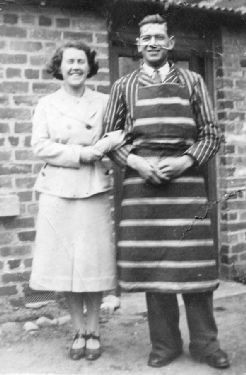
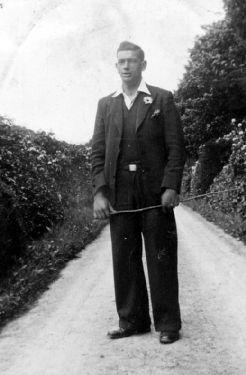
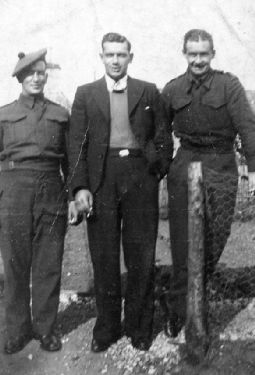
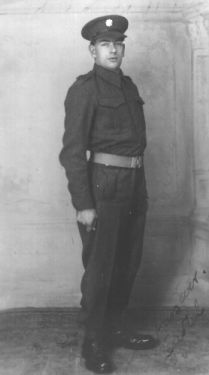
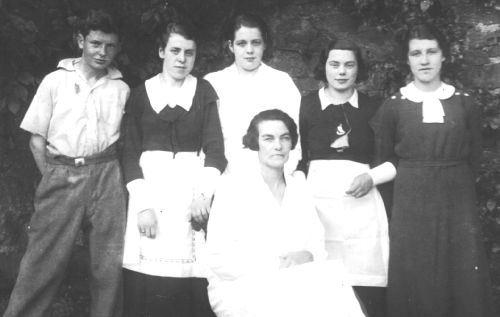
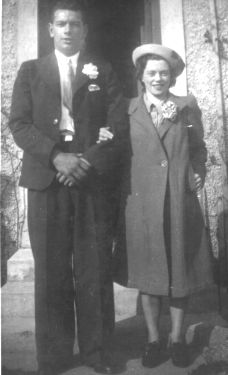
Joey Angus later Joey Melville second right in back row with Ben Bhraggie Hotel staff.
Above Cathel Melville and Joey Angus on their wedding day and below with Bestman (Cecil Melville) and Bridesmaid (Greta Angus).
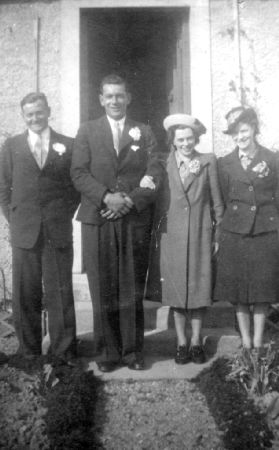
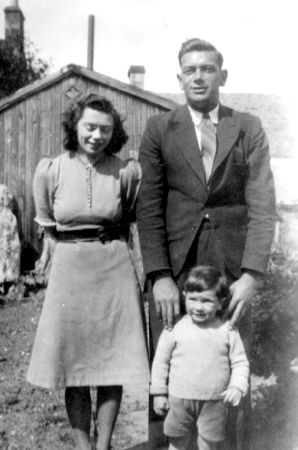
Joey and Cathel, with son David, on one of his leave periods back to Golspie.
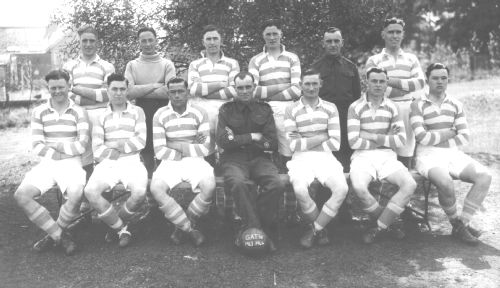
In above picture Cathel third left front row and below he is centre of front row in white shirted team.
Note the famous Sir Matt Busby is in the opposing team.
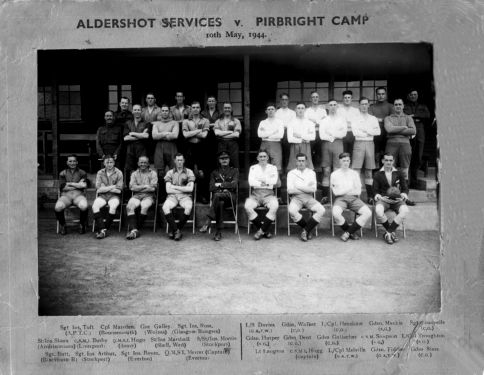
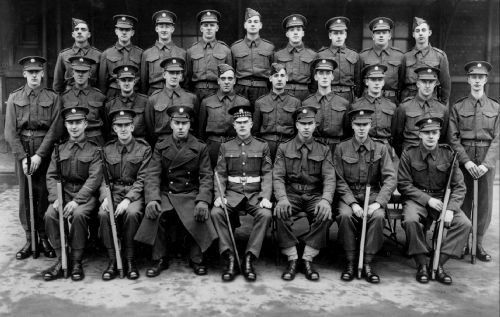
Cathel second left in the back row and in lower picture on extreme left of middle row.
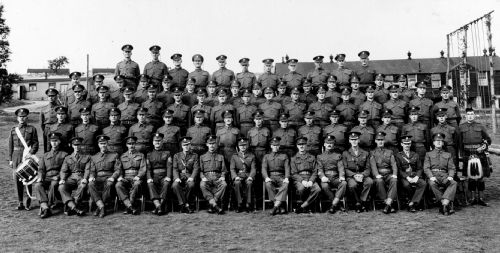
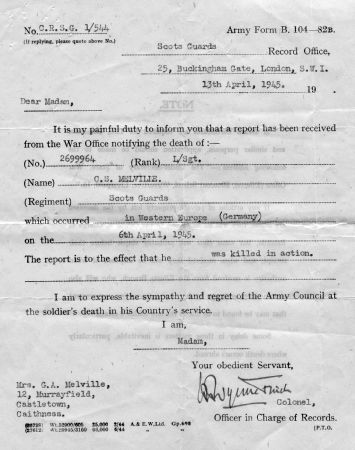
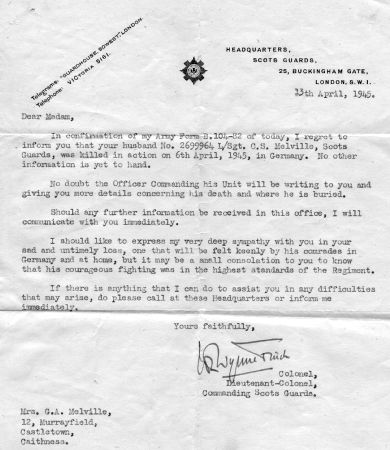
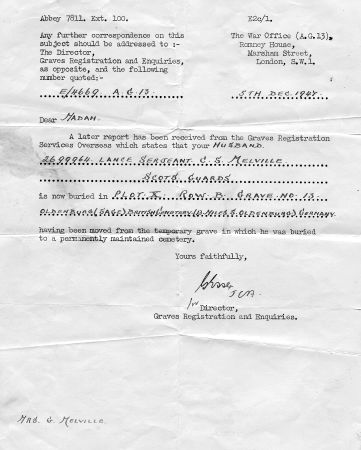
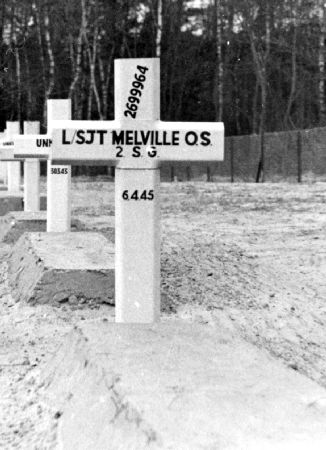
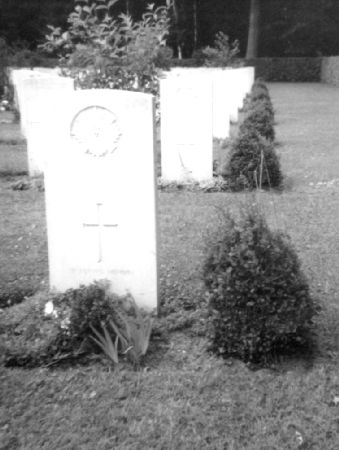
Temporary and Permanent Graves
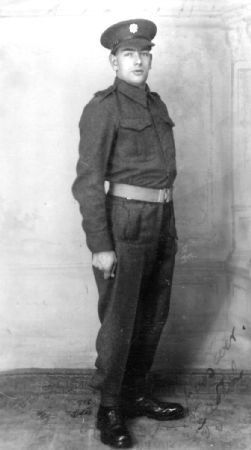
10 May 1944
Cathel Sutherland Melville’s prowess as a local footballer in Sutherland was transferred effectively to his life in the Army. He played regularly for camp and select teams and was rewarded with special leave to represent the Army on a number of occasions.
The photograph shows
Cathel in the Pirbright Camp team when they competed against
a team of professional footballers. Those professionals
played under the name of Aldershot Services and had actually
been recruited to the camp by the army as training
instructors . This
Aldershot eleven contained some notable players not least
being Sir Matt Busby later to become one of
Teams as listed on the ceremonial photograph.
On the right of photograph Pirbright working along the back and then forward in rows from left to right:
L/S Davies, Gdsn.
L/ColTroughon, C.S.M.I. Hogg, L/Cpl Melville, Gdsn.
Fidler, Gdsn. Sims.
And on the left half
of the photograph:
Sgt. Ins. Tofts, Cpl
Marsden (Bournemouth), Gnr. Galley (Wolves), Sgt. Ins.
Ross (
Sgt. Ins. Sloan
(Airdrieonians), C.S.M.I. Busby (Liverpool), Q.M.S.I.
Hugo (Army), Sgt. In. Marshall (Sheffield Wednesday),
S/St/Ins. Morris (